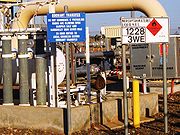
Butanethiol
Encyclopedia
Butanethiol, also known as butyl mercaptan, is a volatile
, clear to yellowish liquid
with a fetid (extremely foul-smelling) odor, commonly described as "skunk
" odor. In fact, butanethiol is structurally similar to several major constituents of a skunk's defensive spray. The scent of butanethiol is so strong that the human nose can easily detect it in the air at concentrations as low as 10 parts per billion.
s, which are organic compounds with molecular formulas and structural formula
s similar to alcohol
s, except that sulfur
-containing sulfhydryl group (-SH) replaces the oxygen
-containing hydroxyl group in the molecule. Butanethiol's basic molecular formula is C4H9SH, and its structural formula is similar to that of the alcohol n-butanol
. Butanethiol is a thiol of low molecular weight, and it is highly flammable.
(which is odorless), and as an intermediate for insecticides and herbicides. It is sometimes placed in the "stink bomb
s" and "stink perfumes" for pranksters.

Volatility (chemistry)
In chemistry and physics, volatility is the tendency of a substance to vaporize. Volatility is directly related to a substance's vapor pressure. At a given temperature, a substance with higher vapor pressure vaporizes more readily than a substance with a lower vapor pressure.The term is primarily...
, clear to yellowish liquid
Liquid
Liquid is one of the three classical states of matter . Like a gas, a liquid is able to flow and take the shape of a container. Some liquids resist compression, while others can be compressed. Unlike a gas, a liquid does not disperse to fill every space of a container, and maintains a fairly...
with a fetid (extremely foul-smelling) odor, commonly described as "skunk
Skunk
Skunks are mammals best known for their ability to secrete a liquid with a strong, foul odor. General appearance varies from species to species, from black-and-white to brown or cream colored. Skunks belong to the family Mephitidae and to the order Carnivora...
" odor. In fact, butanethiol is structurally similar to several major constituents of a skunk's defensive spray. The scent of butanethiol is so strong that the human nose can easily detect it in the air at concentrations as low as 10 parts per billion.
Chemistry
Butanethiol is chemically classified among the thiolThiol
In organic chemistry, a thiol is an organosulfur compound that contains a carbon-bonded sulfhydryl group...
s, which are organic compounds with molecular formulas and structural formula
Structural formula
The structural formula of a chemical compound is a graphical representation of the molecular structure, showing how the atoms are arranged. The chemical bonding within the molecule is also shown, either explicitly or implicitly...
s similar to alcohol
Alcohol
In chemistry, an alcohol is an organic compound in which the hydroxy functional group is bound to a carbon atom. In particular, this carbon center should be saturated, having single bonds to three other atoms....
s, except that sulfur
Sulfur
Sulfur or sulphur is the chemical element with atomic number 16. In the periodic table it is represented by the symbol S. It is an abundant, multivalent non-metal. Under normal conditions, sulfur atoms form cyclic octatomic molecules with chemical formula S8. Elemental sulfur is a bright yellow...
-containing sulfhydryl group (-SH) replaces the oxygen
Oxygen
Oxygen is the element with atomic number 8 and represented by the symbol O. Its name derives from the Greek roots ὀξύς and -γενής , because at the time of naming, it was mistakenly thought that all acids required oxygen in their composition...
-containing hydroxyl group in the molecule. Butanethiol's basic molecular formula is C4H9SH, and its structural formula is similar to that of the alcohol n-butanol
N-Butanol
n-Butanol or n-butyl alcohol or normal butanol is a primary alcohol with a 4-carbon structure and the molecular formula C4H9OH. Its isomers include isobutanol, 2-butanol, and tert-butanol...
. Butanethiol is a thiol of low molecular weight, and it is highly flammable.
Uses
Butanethiol is used as an industrial solvent, as an odorant for natural gasNatural gas
Natural gas is a naturally occurring gas mixture consisting primarily of methane, typically with 0–20% higher hydrocarbons . It is found associated with other hydrocarbon fuel, in coal beds, as methane clathrates, and is an important fuel source and a major feedstock for fertilizers.Most natural...
(which is odorless), and as an intermediate for insecticides and herbicides. It is sometimes placed in the "stink bomb
Stink bomb
A stink bomb or stinkbomb is a device designed to create an unpleasant smell. They range in effectiveness from simple pranks to military grade or riot control chemical agents.The Guinness Book of Records lists two smelliest substances...
s" and "stink perfumes" for pranksters.


